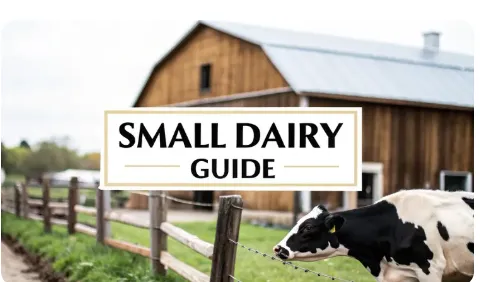
Small Scale Dairy Cattle for Homestead Milk Production: A Complete Guide
Small Scale Dairy Cattle for Homestead Milk Production: A Complete Guide
Bringing a family cow onto your homestead is the ultimate dream for many, but it’s a lifestyle change wrapped in a furry, four-legged package. It’s a decision that goes way beyond the romantic image of a cow grazing in a pasture. You have to get real about the costs, the daily time commitment, and the land you’ll need before you can even think about that first glass of fresh milk.
This honest assessment is the first, and most important, step in small scale dairy cattle for homestead milk production.
Is a Family Cow Right for Your Homestead?
That vision of a cow peacefully chewing her cud is a powerful one, but the reality behind that picture is built on careful planning and serious dedication. Before you even look at a sales listing, you need to understand the full scope of the commitment. This isn't just about adding another animal; it’s about weaving a whole new rhythm into your daily life.
A dairy cow needs milking twice a day, every single day. No exceptions. That routine dictates your schedule, making spontaneous trips or sleeping in a thing of the past unless you have a rock-solid backup plan. And believe me, the commitment extends far beyond the milking stanchion.
Evaluating the True Costs and Needs
The initial purchase price of a cow? That's often the smallest part of the investment. The ongoing expenses are what you really need to budget for, and they add up fast. Feed, especially hay through the winter months, is a substantial and recurring cost.
Beyond the daily feed bill, you’ll need to plan for:
Veterinary Care: Finding a good large-animal vet and getting them on your speed dial is non-negotiable. You’ll need to budget for routine check-ups, vaccinations, and have an emergency fund for those unexpected health scares that always seem to happen on a weekend.
Infrastructure: A simple three-sided shelter can work in many climates, but it has to be sturdy enough to offer real protection from wind, rain, and snow. Secure fencing is just as critical to keep your cow safe and where she belongs.
Land Requirements: A single dairy cow needs at least one to two acres of quality pasture for grazing. This isn't just for exercise; it's to allow for rotational grazing, which is healthier for both the animal and your land.
This chart gives you a pretty clear picture of where your money will go each month.
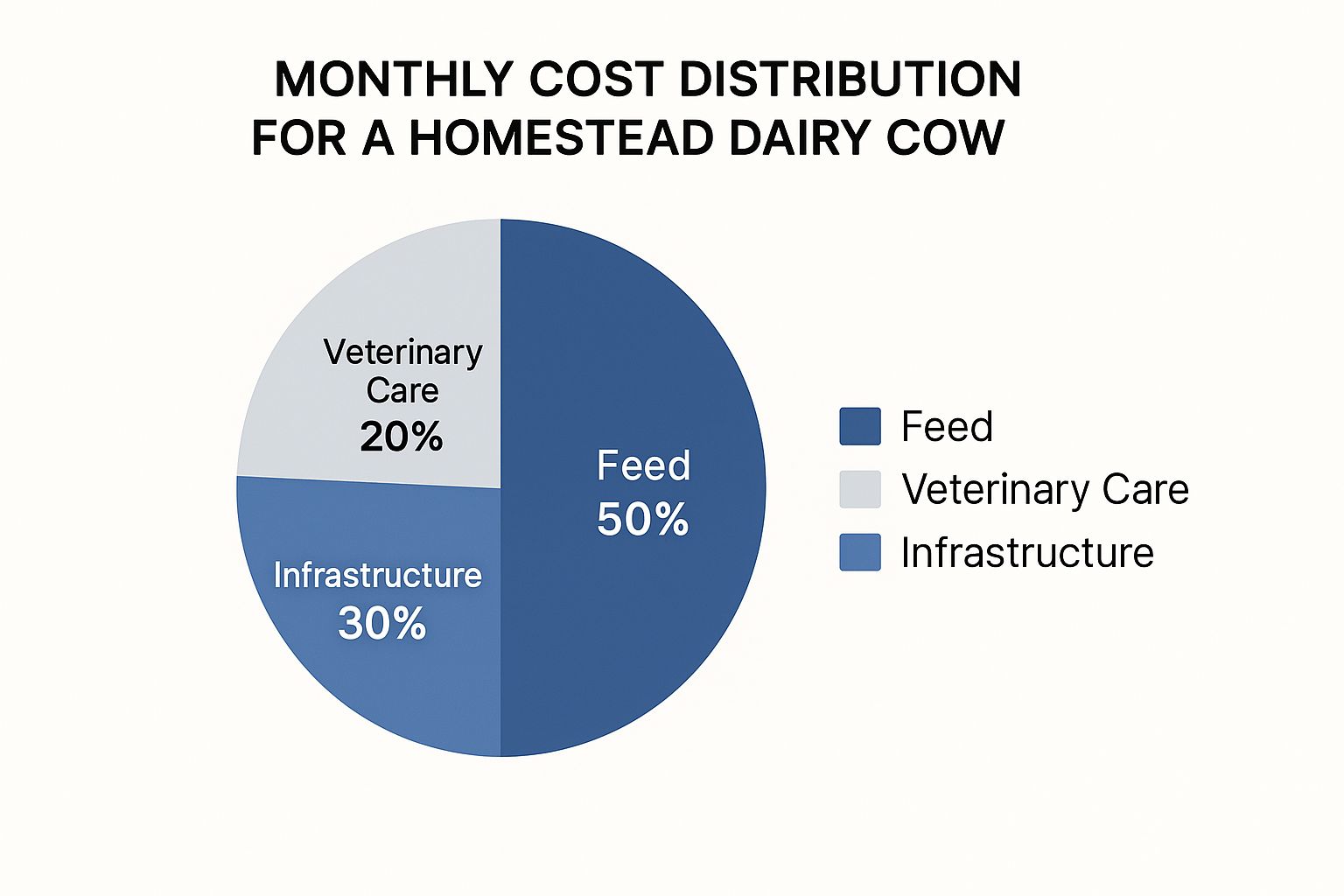
As you can see, feed consistently eats up the largest chunk of the budget. This is why good pasture management is so crucial—it’s the best way to keep those recurring costs down.
The Economic Reality of a Homestead Cow
Let's talk about profitability. The hard truth is that small-scale dairy farming is tough economically. In the U.S., farms milking fewer than 250 cows have faced margin losses in recent years. However, there's a silver lining: projections suggest that improving milk prices could help these smaller operations get back in the black. This shows that while it's a challenge, homestead dairy production is a vital part of local food systems.
To give you a quick, honest look at what you're signing up for, I've put together this table. It breaks down the commitment into a few key areas.
Homestead Dairy Cow Commitment at a Glance

This isn't meant to scare you off, but to prepare you. A family cow is a serious undertaking.
Key Takeaway: A family cow is less a financial investment and more a lifestyle one. The return comes in the form of food security, superior nutrition, and a deeper connection to your food source.
For those just starting their homesteading journey, it's smart to weigh the high demands of a cow against other livestock. If this commitment feels like too much right now, you might want to explore some of the top 7 best low-maintenance homestead animals for beginners. It can be a great way to build your skills and confidence before taking the big leap into dairy.
Choosing the Right Dairy Breed for Your Family
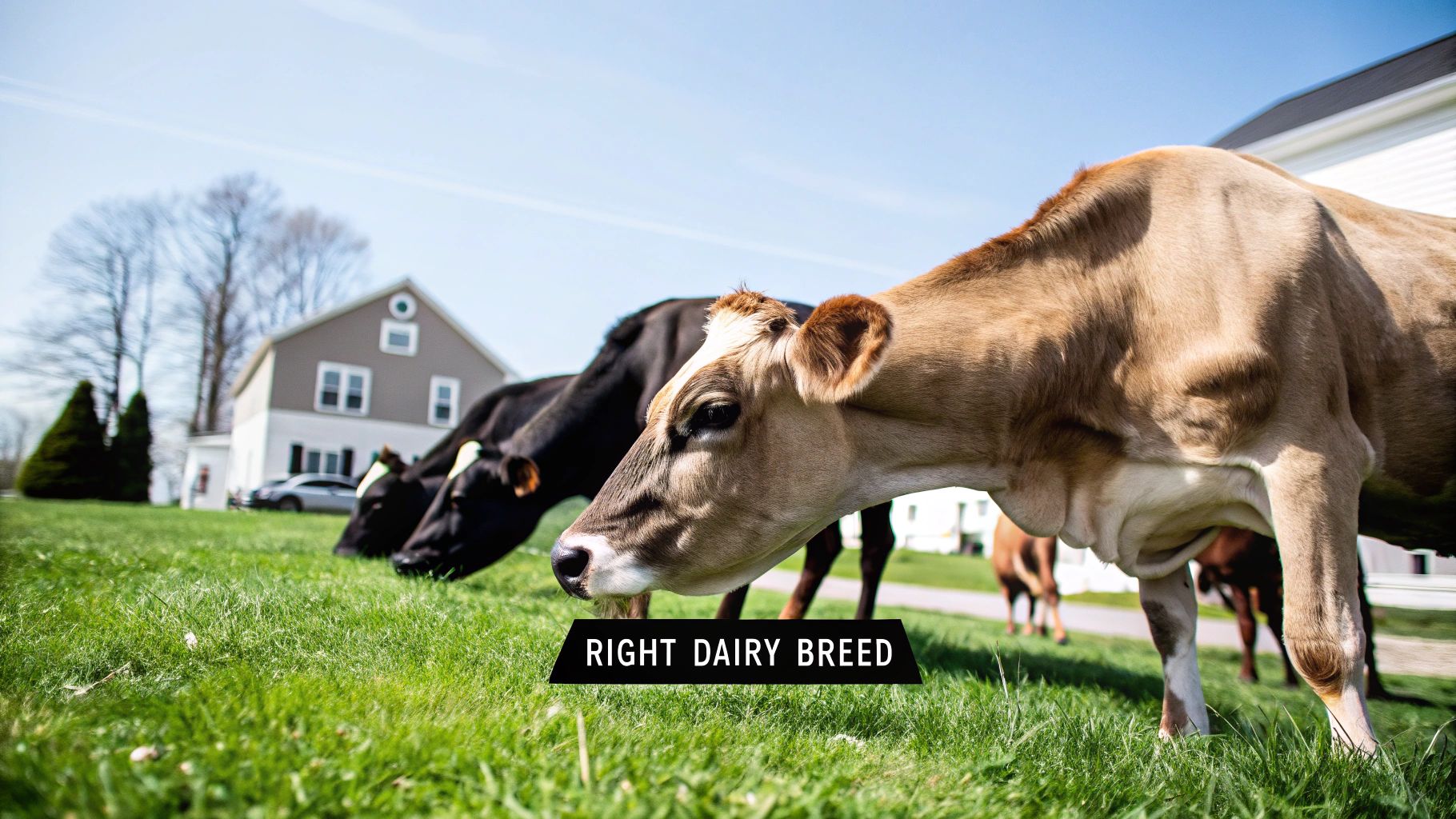
This is easily the most exciting part of getting started with small scale dairy cattle for homestead milk production. When you think of a dairy cow, you probably picture a black-and-white Holstein. They’re the superstars of industrial dairy for their staggering milk volume, but they're a terrible fit for a low-input homestead. We need breeds that are hardy, efficient on grass, and calm enough to be part of the family.
The right cow for your homestead depends entirely on your goals. Are you dreaming of gallons of fresh milk for the kids, or is your heart set on making rich, yellow butter and aged cheeses? Answering that question is the first step toward finding your perfect bovine partner.
Milk Goals and Butterfat Content
First things first: what do you plan to do with all that milk? The butterfat percentage is the single biggest factor that determines what your milk is best for. Higher butterfat means a thicker cream line—the secret to incredible butter, cream cheese, and homemade ice cream.
The Jersey cow is a cream-producing powerhouse. While she gives less liquid volume than some other breeds, her milk is liquid gold, often containing over 5% butterfat. If you’ve got a butter churn on your wish list, a Jersey is tough to beat.
On the flip side, breeds like the Brown Swiss produce milk with a lower butterfat content, typically around 4%. This milk is fantastic for drinking fresh or for making cheeses like mozzarella where too much fat can get in the way.
Temperament and Ease of Handling
A cow’s personality isn’t a bonus feature; it’s a non-negotiable for safety and sanity on a homestead. You’ll be working with this animal up close, every single day. A calm, docile cow makes milking a peaceful morning ritual instead of a stressful rodeo.
Guernseys are a fantastic example. Often called "Golden Guernseys" because their milk is packed with beta-carotene, they’re famous for their gentle and patient nature. This makes them an excellent choice for families with kids or anyone new to handling large livestock. Their laid-back attitude makes training them for the milking stanchion a breeze.
While every animal is an individual, some breeds can be more spirited. It’s always a good idea to talk to breeders and other homesteaders about specific bloodlines, as temperament can vary a lot even within the same breed.
A gentle cow is a safe cow. Never underestimate the importance of a calm disposition, especially when you are hand-milking or have family members helping with chores. Your daily experience depends on it.
Relying on one or two cows for a family’s needs is a tradition that spans the globe. In many parts of Africa, for instance, a household’s daily milk comes from just a couple of cows, proving just how sustainable this model is. This global perspective, highlighted by organizations like the OECD, reminds us that small-scale dairying is a time-tested path to self-sufficiency.
Dual-Purpose Breeds for Small Homesteads
If you're working with limited space or want both milk and the option for beef down the road, a dual-purpose breed is a brilliant solution. These cattle are generally smaller and more efficient on pasture, making them a perfect match for a compact homestead.
The Dexter is the undisputed star of this category. As one of the smallest cattle breeds, standing just 36-44 inches at the shoulder, they are incredibly efficient. A Dexter can thrive on less pasture than a big dairy breed while still giving you 1-2 gallons of rich milk per day. Plus, they produce beautifully marbled, delicious beef.
The Milking Shorthorn is another stellar dual-purpose choice. They offer a great balance, providing a good quantity of milk while their bull calves grow out nicely for the freezer. For homesteaders who prize versatility and want to get the most from a single animal, these breeds are a perfect fit. If raising cattle for meat is a primary goal, it's also worth exploring our guide on the best beef cattle for homesteading to compare different approaches.
Comparing Top Homestead Dairy Breeds
To help you visualize the differences, here’s a quick comparison of some of the best breeds for a small homestead. Each has its own unique strengths, so think about which one aligns best with your land and your family's needs.

Ultimately, choosing the right cow is a personal decision. It's about finding the animal whose traits are the best match for your land, your lifestyle, and your homesteading dreams.
Creating the Ideal Pasture and Shelter
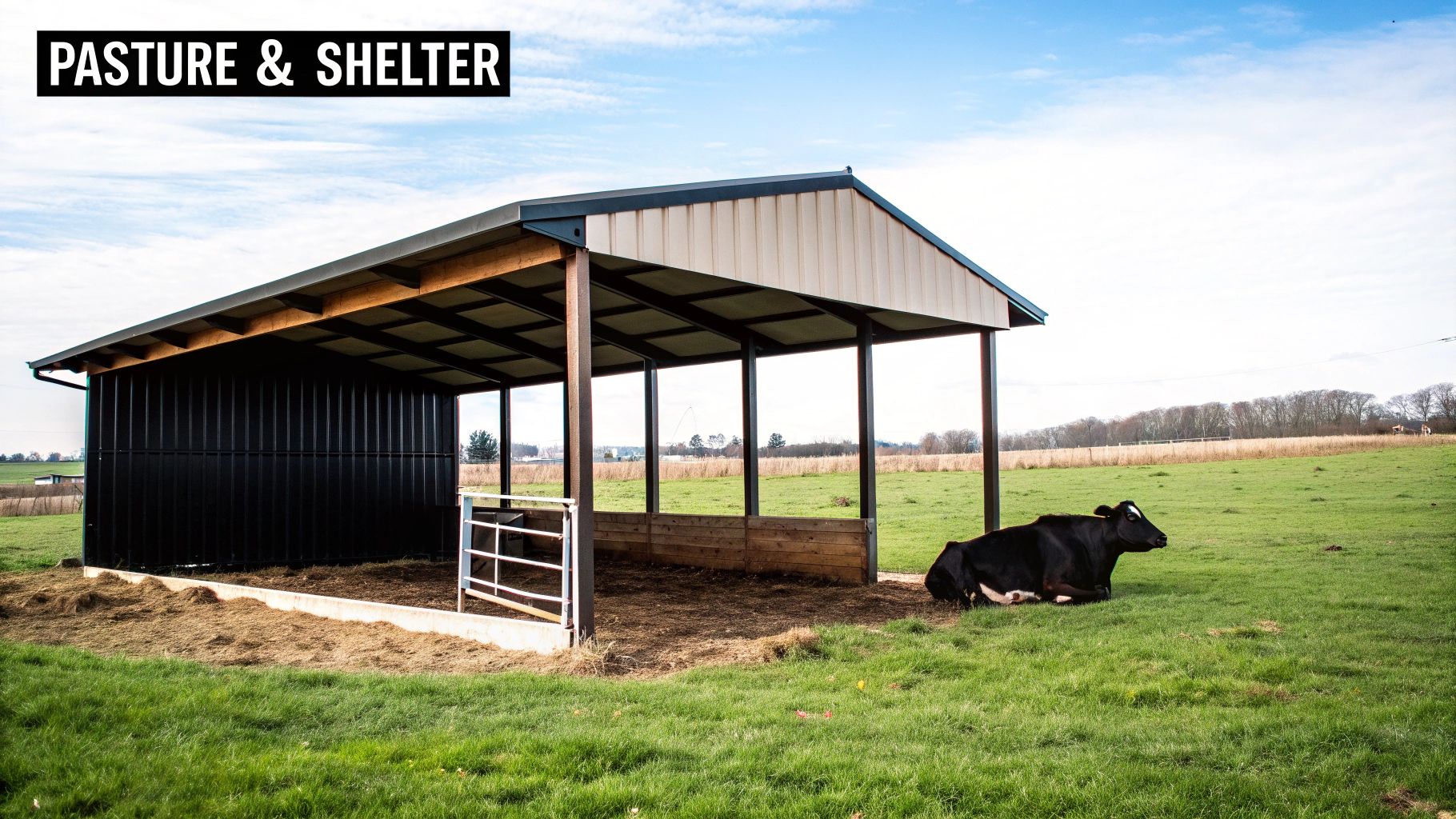
A healthy dairy cow is a happy dairy cow, and her happiness starts with her home. Before you even think about bringing your cow onto the homestead, your first job is to set up a safe, comfortable space. This isn't about building a fancy, expensive barn. It’s about meeting her basic needs for shelter, clean water, and good grass—the foundation of all small scale dairy cattle for homestead milk production.
Think of your cow’s living space as more than just a place to sleep. It’s her refuge from a scorching sun or a biting winter wind, a clean place for you to milk, and a safe spot for her to rest and chew her cud. Getting this right from the start will save you a world of trouble with health issues and make your daily chores something you look forward to.
Designing the Right Shelter
You really have two options for housing your homestead cow: a simple run-in shed or a more traditional barn. Honestly, for most homesteads, a three-sided run-in shelter is the perfect fit. It's cost-effective, relatively easy to build, and gives a cow exactly what she needs—protection from wind and rain while offering fantastic ventilation.
Make sure the open side faces away from the prevailing winter winds. As for size, 80-100 square feet per cow is a good rule of thumb, giving her plenty of room to stand, turn around, and lie down. The single most important feature? It has to stay dry. A dirt floor is fine if it’s on high ground, but a thick layer of bedding is non-negotiable.
Wood Shavings: Super absorbent and easy to muck out, but they can be a recurring cost.
Straw: My personal favorite. It’s great insulation in the winter and breaks down into beautiful compost for the garden.
Sand: Drains really well and, being inorganic, can help keep bacteria down. The downside is it's heavy to manage.
A deep bedding method, where you layer fresh bedding on top and do a full clean-out just a few times a year, is a huge labor-saver and produces incredible compost.
Managing Pastures for Health and Productivity
Your pasture is so much more than an exercise pen—it's your cow's dinner plate for most of the year. The goal is to manage it so that it benefits both your cow and your land. This is where rotational grazing becomes your best friend.
Instead of letting your cow have the whole pasture at once, you use temporary fencing to divide it into smaller sections, or paddocks. She grazes one area down for a few days, then you move her to the next. It’s a simple concept with game-changing results.
By allowing grazed sections to rest and regrow, you prevent overgrazing, encourage deeper root growth in your grasses, and help break the life cycle of internal parasites. It’s one of the most powerful tools a homesteader has for building soil health and reducing feed costs.
Fencing and Water: A Non-Negotiable Foundation
Good fencing isn't just a suggestion; it's a matter of safety for your cow, your garden, and your neighbors. I’ve found that a combination of sturdy perimeter fencing and flexible interior fencing works best.
Perimeter Fencing: Woven wire is a secure, long-lasting choice for the outer boundaries of your property.
Interior Fencing: Portable electric fencing, like polywire or netting, is perfect for creating those temporary paddocks for rotational grazing. It’s easy to move and teaches a cow to respect a fence line in a hurry.
Finally, let’s talk water. A constant supply of fresh, clean water is absolutely critical. A milking cow can guzzle over 30 gallons of water on a hot day. A large stock tank hooked up to an automatic float valve is the ideal, low-fuss solution. It ensures she always has what she needs to stay hydrated and healthy, which is the key to all that wonderful homestead milk.
Mastering Your Cow's Feed and Daily Care
Understanding what goes into your cow is the absolute key to her health and the quality of milk that ends up in your pail. Proper nutrition is really the foundation of small scale dairy cattle for homestead milk production, turning good pasture into rich, wholesome milk for your family. It’s an art and a science, blending sharp observation with a clear understanding of what she needs to thrive.
A dairy cow’s diet isn’t static—it shifts with the seasons and her lactation cycle. The core of her diet, though, should always be high-quality forage. That means lush pasture in the growing season and excellent hay during the winter. This is the fuel that powers her body and her milk production.
Building the Perfect Bovine Diet
The bulk of your cow's daily intake, somewhere around 80% or more, should come from forage. A common mistake new homesteaders make is over-relying on grain.
Think of grain as a targeted supplement, not the main course. You use it to provide the extra energy a cow needs during peak lactation or to help her maintain condition, but it should never, ever replace high-quality hay or grass.
When your pasture is dormant, the quality of your hay is paramount. You want what's known as "cow-quality" hay—generally a second or third cutting that's leafy and green, not coarse, stemmy, and yellow. Poor-quality hay lacks the necessary protein and energy, forcing you to compensate with more expensive grain and supplements just to keep her in good shape.
To support her entire system, your cow needs constant access to a few key free-choice supplements. These are not optional extras; they are absolutely essential for her long-term health.
Loose Minerals: Provide a high-quality loose mineral mix specifically formulated for cattle, not an all-stock mix. She knows what her body needs and will consume what she requires to support everything from bone health to reproduction.
Plain Salt: A separate salt block or loose salt is crucial. Minerals and salt should be offered separately, as her need for salt can fluctuate completely independently of her need for other minerals.
Kelp Meal: Offering free-choice kelp provides a fantastic source of micronutrients and iodine that are often missing from pasture and hay.
This simple setup allows her to balance her own nutritional needs instinctively. It’s pretty amazing to watch.
Adjusting Feed for the Lactation Cycle
A cow's dietary requirements shift dramatically throughout her lactation cycle. Getting a handle on these changes is crucial for keeping her healthy and productive. The cycle really breaks down into three main phases.
Early Lactation (First 100 Days): This is when her milk production is highest, and so are her energy demands. She will likely be in a negative energy balance, meaning she's using more energy than she can possibly consume. This is the time to offer a small amount of supplemental grain on the milk stand to support her production and prevent her from losing too much body condition.
Mid to Late Lactation: As her milk production naturally begins to taper off, you can gradually reduce her grain ration. At this point, good pasture or high-quality hay should be more than enough to meet her needs.
The Dry Period: During the two months before she calves again, she needs a complete break from milking and a diet of only good-quality forage. This period is vital for her. It's when she rests, grows a healthy calf, and rebuilds her body's reserves for the next lactation.
The goal is to match her energy intake with her energy output. Observing her body condition is your best guide. You should be able to feel her ribs with firm pressure but not see them clearly.
The demand for dairy products continues to grow worldwide, underscoring the vital role milk plays in global food systems. Even as large-scale farming expands to meet this need, small-scale homestead production remains a cornerstone of food security and local resilience. You can discover more insights about the global dairy market on avm-ua.org.
The Daily Health Checkup
Beyond feeding, a quick daily health check is your first line of defense against common problems. This doesn't have to be a formal, drawn-out examination. It's all about developing an eye for what's normal for your cow, so you can spot what's not, fast.
Spend a few minutes just observing her every morning and evening. Is she alert and chewing her cud? Is her coat shiny and her eyes bright? Is her manure a normal consistency? These simple observations can tell you volumes about her well-being.
Before you ever need one, establish a relationship with a large-animal veterinarian. Have their number ready and don't hesitate to call if you suspect something is off. Early intervention for issues like mastitis or bloat can be the difference between a minor issue and a serious emergency. Being proactive is the hallmark of a responsible and successful homestead dairy steward.
The Art of Milking and Handling Fresh Milk
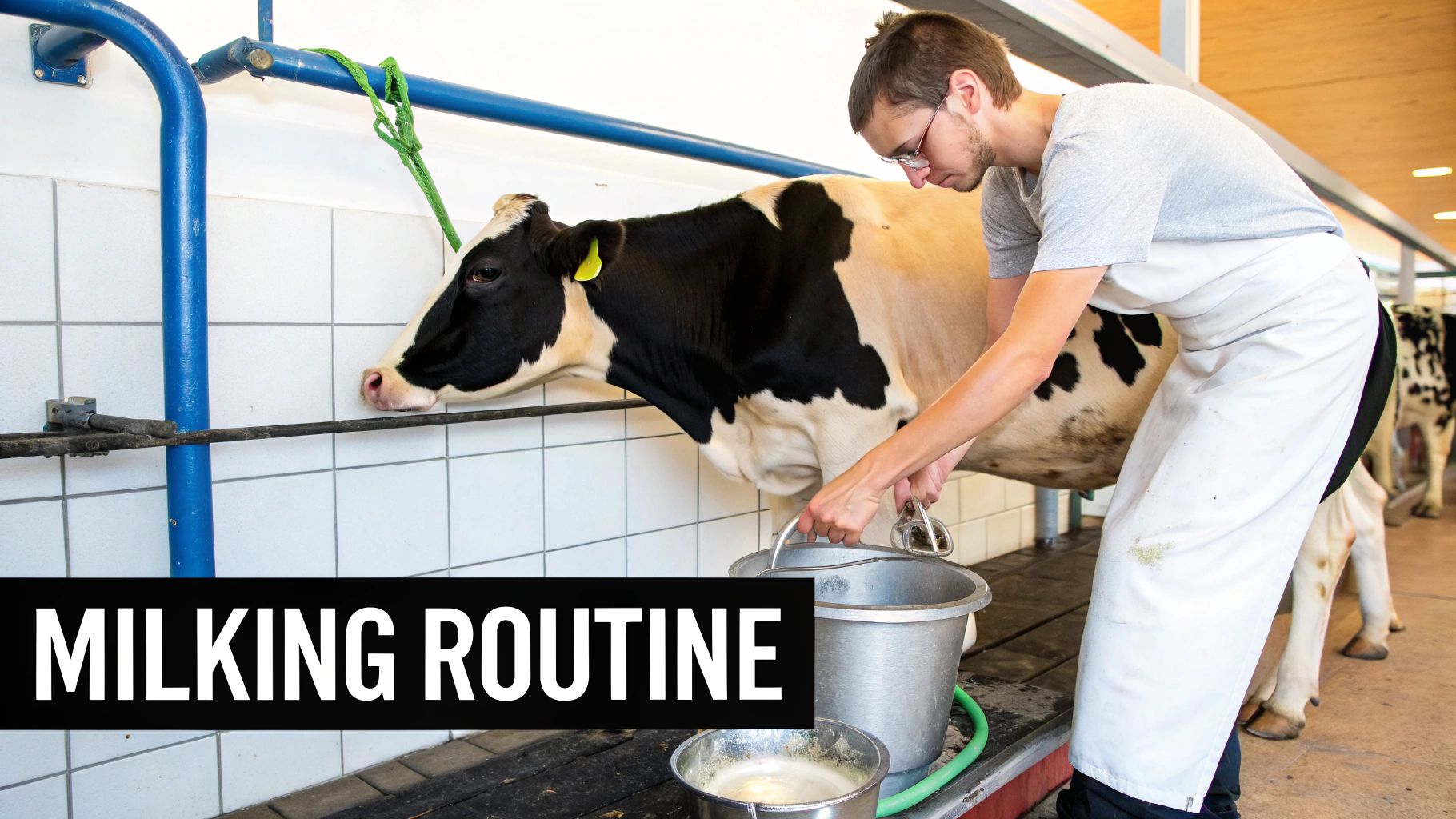
This is the moment it all comes together. The twice-daily rhythm of milking is where your hard work and good care pay off in the form of wholesome, nutrient-rich food. This is the heart of having small scale dairy cattle for homestead milk production.
More than anything, a calm, clean, and consistent routine will make this a peaceful ritual for both you and your cow. A stressed cow won't let down her milk properly, so your first job is creating a serene space. Whether you milk by hand or use a machine, the principles are the same. Consistency is your best friend—try to milk at the same time, in the same quiet spot, every single day.
Mastering a Clean Milking Routine
Sanitation isn't just a suggestion; it's the absolute cornerstone of producing safe, delicious milk. Bacteria are everywhere, and your goal is to keep them out of your milk from the moment it leaves the udder. A simple, repeatable process is all it takes.
This routine should become second nature, a non-negotiable part of every single milking.
Brush and Clean: Start by brushing any loose dirt, hay, or hair from her flank and udder. This simple step keeps debris from falling into your clean milk pail.
Wash and Dry: Use a warm, soapy cloth or a special udder wash to clean each teat. Then—and this is critical—dry each teat completely with a separate, clean cloth. A wet udder can let bacteria drip right into the milk.
Strip the Teats: Before you start milking for real, squirt the first few streams from each teat onto the ground or into a strip cup. This clears out any bacteria that might have gathered in the teat canal.
Milk Out: Go ahead and milk, either by hand or machine, until the udder is empty.
Apply Post-Dip: As soon as you’re done, dip each teat in an iodine-based teat dip. This crucial step sanitizes the teat ends and creates a barrier against bacteria while the teat canal closes back up.
The mantra for every homesteader should be: "Clean in, clean out." A meticulously clean process from start to finish is the only way to guarantee the quality and safety of your family's milk supply.
Handling and Storing Your Liquid Gold
The work isn’t over once the pail is full. How quickly you cool your milk has a massive impact on its flavor and shelf life. Warm milk is the perfect breeding ground for bacteria, so your main goal is to chill it as fast as you can.
The target is to get the milk temperature down to around 40°F (4°C) within two hours. An ice bath is the most effective way to do this on a small scale. Just place your stainless steel milk pail into a larger tub or sink filled with ice and water. Give the milk a gentle stir now and then to help it cool evenly.
Once it's chilled, filter the milk through a single-use milk filter into sanitized glass jars. Pop them in the fridge, and you're all set. Fresh, properly handled raw milk will typically last for 7-10 days.
The Pasteurization Question
Deciding whether to pasteurize your milk is a personal choice for every homestead. Pasteurization involves heating the milk to 161°F (72°C) for 15 seconds to kill potentially harmful bacteria. On the flip side, this process also destroys some of the beneficial enzymes and probiotics present in raw milk.
Many homesteaders who are confident in their sanitation and the health of their cow choose to drink their milk raw. Others prefer the peace of mind that comes with pasteurization, especially if they're serving milk to children or guests. There's no single right answer here; it's about understanding the risks and benefits to make an informed decision for your family.
The rich cream you skim off the top is perfect for creating other dairy products. If you're interested in taking your homestead dairy to the next level, our guide on making butter from whole milk is a fantastic place to start.
Answering Your Homestead Dairy Cow Questions
Getting started with a family milk cow is an exciting step, but it’s one that naturally brings up a lot of questions. As you move from the dream to the day-to-day reality, a few key topics always seem to surface.
Let's walk through the most common questions I hear from new homesteaders. These aren't textbook answers; they're grounded in the practical, real-world experience of living with and caring for a dairy animal.
How Much Milk Can I Realistically Expect?
This is usually the first thing people ask, and the honest answer is: it depends. A cow's milk production isn't a fixed number. It’s a curve influenced by her breed, genetics, what she's eating, and where she is in her lactation cycle.
A high-production Jersey cow, for instance, might give you 3-5 gallons of rich, creamy milk a day at her peak. A smaller, dual-purpose Dexter, on the other hand, will offer a more modest but still generous 1-2 gallons daily.
Remember, milk production follows a natural rhythm. A cow gives the most milk in the months right after calving, and that volume will slowly taper off over her 10-month lactation period. For most families, even one gallon a day is a huge abundance for drinking, making butter, and trying your hand at cheesemaking.
What Do I Do When the Cow Needs a Dry Period?
Every dairy cow needs—and deserves—a "dry period." This is her mandatory two-month vacation from milking before she’s due to calve again. You stop milking her completely. This rest allows her body to recover, funnel nutrients to her growing calf, and get her udder ready for the next round.
So, what about your milk supply? Homesteaders have a few clever ways to handle this milk-free window:
Stock the Freezer: In the months leading up to her dry period, start freezing milk. It thaws perfectly for drinking and cooking.
Enjoy Aged Goods: This is the perfect time to break out the aged cheeses you made when milk was flowing freely.
Stagger Your Herd: Some homesteaders with enough space and resources keep two cows on opposite calving schedules, guaranteeing a year-round milk supply.
This rest period is non-negotiable for the long-term health and productivity of your cow. Honoring her natural cycles is a core part of responsible animal stewardship.
Should I Use AI or Keep a Bull?
For almost every single homestead situation, the answer is clear and emphatic: use artificial insemination (AI). Keeping a dairy bull on a small farm is an enormous safety risk that requires specialized, expensive infrastructure you probably don't have.
Dairy bulls are notoriously unpredictable and can be incredibly dangerous, even ones raised gently from birth. The liability and the sheer physical risk just aren't worth it.
AI is a far safer and more practical solution. It gives you access to top-tier genetics from proven sires all over the country without the danger, cost, and hassle of feeding a 1,500-pound bull all year for one job. Your first step should be finding a good local AI technician to add to your network.
What Are the Biggest Hidden Costs?
You've budgeted for the cow and her feed, but what are the costs that sneak up on you? The two biggest surprises are almost always emergency vet bills and breeding fees.
It's a smart move to start a dedicated "cow fund" for health emergencies. A difficult calving, a case of mastitis, or a sudden illness can easily run up a vet bill of several hundred dollars or more. Being financially ready for that possibility removes a massive layer of stress.
Other costs that often surprise new owners are ongoing fence repairs, the need for better equipment like hay feeders, and the consistent expense of good mineral supplements. And don't forget the "cost" of your own time—a dairy cow requires your dedicated attention twice a day, every single day, no exceptions.
At The Grounded Homestead, our goal is to provide the practical knowledge you need to confidently grow your own food and live a more self-sufficient life. Explore our other guides and articles to continue your homesteading journey at https://thegroundedhomestead.com.


Facebook
Instagram
X
Youtube